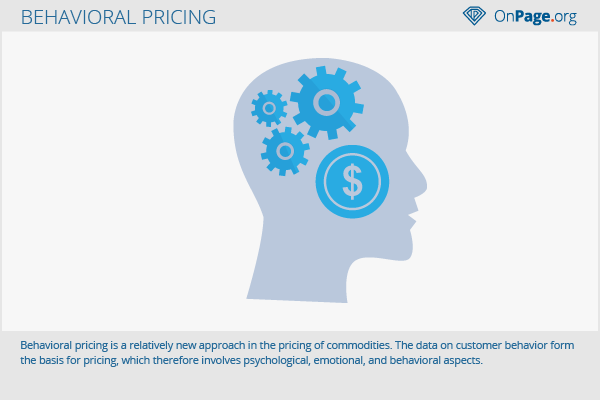Behavioral Pricing
Behavioral pricing is a relatively new approach in the pricing of commodities. Pricing for a product is determined based on the behavior of potential customers. Behavior can be ascertained in different ways, for example, with the search history in the browser, click paths when shopping online, demographic data, and profiles on social networks.[1]
The data on customer behavior form the basis for pricing, which therefore involves psychological, emotional, and behavioral aspects.
General information
Simply put, in classic price theory it is assumed that rational factors determine customer behavior, that customers have the full information about the prices and that all customer preferences are perfectly clear. The customer selects a price (the product), and assumes that his benefits from that product will be maximized by this purchase.
Such cost-benefit models do not take into account the fact that customers do not always behave rationally. They differ in their behavior from the assumptions of the classical pricing theory; they evaluate a price with regard to various factors, such as the reputation of the manufacturer or their own capital. They also do not behave in a linear fashion. They may cancel their product search and return to it later. They can’t remember prices and do not always make specific comparisons.
Decisions on prices therefore are apparently based on various aspects. Rational considerations are only one facet in pricing. Emotional, psychological, and especially cognitive aspects in the classical theory only play a marginal role. Behavioral pricing focuses on the subjective factors and tries to understand how consumers decide on a price for a product.
How it works
In behavioral pricing, it is believed that the perception of a price from the potential customer's perspective is much more complex. Behavioral pricing is not intended to replace the classical approach, but rather to complement it. The focus is on questions such as:
- How do customers perceive price information and process it?
- How do they react to price quotes?
- How do customers use price information in their judgments and decisions?
The basis for these cognitive processes is a stimulus-response scheme that is meant to explain actions taken by the customer. The starting point is a stimulus. It is perceived by a consumer and results in a subjective assessment on their part. The result is individual behavior, which is also called a reaction.
Example
Suppose a consumer is looking for a winter jacket. He uses Google search and visits various online stores or merchant platforms. One retailer uses behavioral pricing and registers his visit. The retailer may possibly also read related data such as search history in the browser or the breadcrumb on the website. The consumer leaves the platform at first and decides two weeks later to visit the product page again. Due to the fact that this consumer has already viewed the product page once, the retailer knows that the consumer is interested in that product.
If the consumer now visits this product page once more, the retailer could use this information to increase the price of the winter jacket. This indeed occurs in practice. When consumers visit certain stores and product pages several times, the prices of products will be marginally changed - for example, by 5%. For the consumer, this is a signal that he must strike. He assumes that the price could rise further. He perceives the price information. He processes and evaluates it in such a way as to evoke a reaction and action. He remembers the price on his first visit to the product page.
Behavioral pricing structure
Accordingly, a rough behavioral pricing structure could look like this:
- Receipt of price information: Factual information such as offer, consulting, and transparent descriptions of the goods are the objective starting position.
- Price information assessment: The consumer’s attitude, his perception and interpretation of the factual information result in an assessment. Sometimes other information can be in the mix that has nothing to do with the goods, such as a change in financial circumstances.
- Price information response: This behavior may be a purchase, a non-purchase or a postponement. In the case of a postponement, the process begins again and the consumer may remember the first price he saw.
Importance for search engine optimization
Any data collected by online shops and distributors about their customers gets applies in behavioral pricing. Behavioral pricing can be considered cognitive computing, since the system learns through the behavior of its users. For e-commerce, this may be an opportunity to achieve greater profit or to gain a larger customer base. However, such an approach is also associated with various aspects of big data, tracking, and web analytics.
Since price changes based on consumer behavior is still a relatively new subject, no solid evidence exists with regard to long-term impact on the market and consumers. The user might very well switch to another distributor if the price of a product is increased. From the consumer perspective behavioral price changes are not beneficial. However, price changes may be considered from both aspects. If a competitor observes the pricing of another competitor, he may adjust his pricing and thereby gain a competitive advantage.
Consumers will include rational aspects in their purchasing decisions despite the behavioral approach. They could opt for the lowest price, or make their purchase price based on price image. There are many aspects that come into play when making purchasing decisions. Thus, the data collected must not necessarily be used to define the best price. It can also shape optimal pricing policy.
References
- ↑ Behavioral Pricing: A consumer's worst nightmare, a merchant's dream thenextweb.com. Accessed on 05/18/2015

